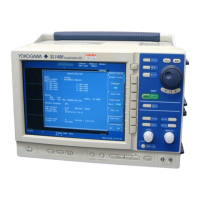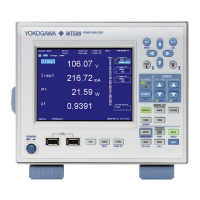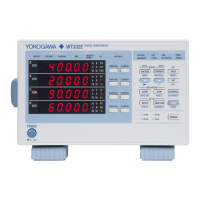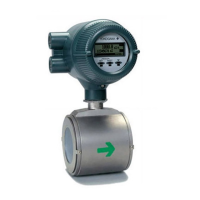3-33
IM 701240-01E
3
3
2
1
4
5
6
7
8
9
10
11
12
13
14
15
16
17
18
App
Index
Preparations for Measurements
3.13 Connecting Acceleration Sensors
When Connecting Charge Output Type Acceleration Sensors
Since the charge output type (high impedance) acceleration sensors do not have a built-
in amplifier circuit, they cannot be directly connected to the SL1400. Use either of the
following two methods to connect the sensors.
Using the Charge Amplifier
Connect the charge output type acceleration sensor to a charge amplifier using a
highly isolated low-noise cable. The acceleration signal (charge signal) that has been
converted to a voltage signal by the charge amplifier is applied to the SL1400 using a
normal coaxial cable. The SL1400 measures the signal in the voltage measurement
mode. The measured data can be converted to acceleration values using the scale
conversion function of the SL1400.
701275(ACCL/VOLT)
(Voltage measurement)
Charge output type
acceleration sensor
Normal
coaxial
cable
Highly isolated
low-noise cable
Charge amplifier
SL1400
Using the Charge Converter
Connect the charge output type acceleration sensor to a charge converter using a
highly isolated low-noise cable. By driving the charge converter using a constant
current from the SL1400, voltage signals similar to those of the built-in amplifier type
acceleration sensor can be obtained. The SL1400 measures the signals in the
acceleration measurement mode and supplies bias current to the charge converter.
Set the input sensitivity of the SL1400 according to the charge converter gain and the
sensitivity of the charge output type acceleration sensor.
The SL1400 only supports charge converters that are driven by constant current with
driving current of 4 mA and driving voltage of 22 V.
Charge output type
acceleration sensor
Normal
coaxial
cable
Highly isolated
low-noise cable
Charge
converter
701275(ACCL/VOLT)
(Acceleration measurement)
SL1400
Note
The unit of measurement of acceleration on the SL1400 is m/s
2
. The sensitivity is sometimes
expressed in units of mV/G depending on the acceleration sensor. In such cases, convert the
unit. (1 G = 9.81 m/s
2
)
Precautions
• Do not apply shock outside the specifications (see the manual for the acceleration
sensor) to the acceleration sensors. Doing so can damage the sensors.
• Do not impose drastic temperature changes on the acceleration sensors.
Temperature changes may affect the output value of the acceleration sensors.
• By default, the bias current on the acceleration sensors is turned OFF. Be sure to turn
it ON before using the acceleration sensors. Bias current is valid only when measuring
acceleration. When measuring other parameters, it is automatically turned OFF. The
ON/OFF setting of the bias current is retained even when you turn OFF the SL1400.

